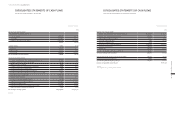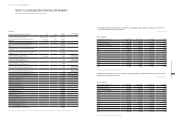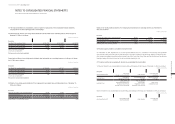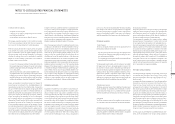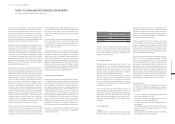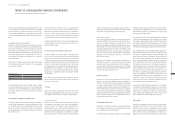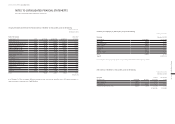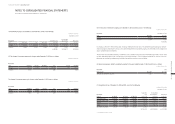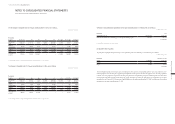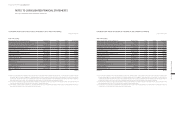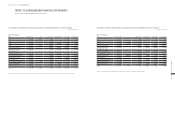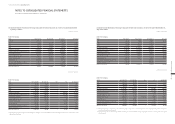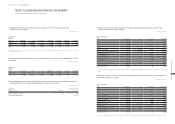Hyundai 2014 Annual Report Download - page 53
Download and view the complete annual report
Please find page 53 of the 2014 Hyundai annual report below. You can navigate through the pages in the report by either clicking on the pages listed below, or by using the keyword search tool below to find specific information within the annual report.
HYUNDAI MOTOR COMPANY Annual Report 2014
FINANCIAL STATEMENTS / 105104
required to settle the present obligation at the end of the re-
porting period, taking into account the risks and uncertainties
surrounding the obligation. A provision is measured using the
present value of the cash flows estimated to settle the present
obligation. The increase in provision due to passage of time is
recognized as interest expense.
The Group generally provides a warranty to the ultimate con-
sumer for each product sold and accrues warranty expense at
the time of sale based on actual claims history. Also, the Group
accrues probable expenses, which may occur due to product lia-
bility suit, voluntary recall campaign and other obligations at the
end of the reporting period. In addition, the Group recognizes
provisions for the probable losses of unused loan commitment,
construction contracts, pre-contract sale or service contract
due to legal or constructive obligations.
When some or all of the economic benefits required to settle
a provision are expected to be recovered from a third party, a
receivable is recognized as an asset if it is virtually certain that
reimbursement will be received and the amount of the receivable
can be measured reliably.
(21) Taxation
Income tax expense is composed of current and deferred tax.
1) Current tax
The current tax is computed based on the taxable profit for the
current year. The taxable profit differs from the income before
income tax as reported in the consolidated statements of income
because it excludes items of income or expense that are taxable
or deductible in other years and it further excludes items that
are never taxable or deductible. The Group’s liability for current
tax expense is calculated using tax rates that have been enacted
or substantively enacted by the end of the reporting period.
2) Deferred tax
Deferred tax is recognized on temporary differences between
the carrying amounts of assets and liabilities in the consolidated
financial statements and the corresponding tax bases used in the
computation of taxable profit. Deferred tax liabilities are general-
ly recognized for all taxable temporary differences. Deferred tax
3) Current and deferred tax for the year
Current and deferred tax are recognized in profit or loss, except
when they relate to items that are recognized in other compre-
hensive income or directly in equity, or items arising from initial
accounting treatments of a business combination. The tax effect
arising from a business combination is included in the account-
ing for the business combination.
(22) Treasury stock
When the Group repurchases its equity instruments (treasury
stock), the incremental costs and net of tax effect are deduct-
ed from equity and recognized as other capital item deducted
from the total equity in the consolidated statements of financial
position. In addition, profits or losses from purchase, sale or re-
tirement of treasury stocks are directly recognized in equity and
not in current profit or loss.
(23) Financial liabilities and equity instruments
Debt instruments and equity instruments issued by the Group are
recognized as financial liabilities or equity depending on the con-
tract and the definitions of financial liability and equity instrument.
1) Equity instruments
An equity instrument is any contract that evidences a residual
interest in the assets of an entity after deducting all of its liabil-
ities. Equity instruments issued by the Group are recognized at
issuance amount net of direct issuance costs.
2) Financial guarantee liabilities
A financial guarantee contract is a contract that requires the
issuer to make specified payments to reimburse the holder for a
loss it incurs because a specified debtor fails to make payment
when due in accordance with the original or modified terms of a
debt instrument.
Financial guarantee contract liabilities are initially measured at
their fair values and, if not designated as at FVTPL, are subse-
quently measured at the higher of:
■ the amount of the obligation under the contract, as deter-
assets shall be generally recognized for all deductible temporary
differences to the extent that it is probable that taxable profits
will be available against which those deductible temporary dif-
ferences can be utilized. Such deferred tax assets and liabilities
shall not be recognized if the temporary difference arises from
goodwill or from the initial recognition (other than in a business
combination) of other assets and liabilities in a transaction that
affects neither the taxable profit nor the accounting profit.
Deferred tax liabilities are recognized for taxable temporary
differences associated with investments in subsidiaries and as-
sociates, and interests in joint ventures, except when the Group
is able to control the timing of the reversal of the temporary
difference and it is probable that the temporary difference will
not reverse in the foreseeable future. Deferred tax assets aris-
ing from deductible temporary differences associated with such
investments and interests are only recognized to the extent that
taxable profit will be available against which the temporary dif-
ference can be utilized and they are expected to be reversed in
the foreseeable future.
The carrying amount of deferred tax assets is reviewed at the
end of each reporting period and reduced to the extent that it is
no longer probable that sufficient taxable profits will be avail-
able to allow all or part of the asset to be recovered.
Deferred tax assets and liabilities are measured at the tax rates
that are expected to be applied in the period in which the liabil-
ity is settled or the asset is realized, based on tax rates and tax
laws that have been enacted or substantively enacted by the
end of the reporting period. The measurement of deferred tax
assets and liabilities reflects the tax consequences that would
follow from the manner in which the Group expects to recover
or settle the carrying amount of its assets and liabilities at the
end of the reporting period.
Deferred tax assets and liabilities are offset when there is a
legally enforceable right to offset current tax assets against
current tax liabilities and when they relate to income tax lev-
ied by the same taxation authority. Also, they are offset when
different taxable entities which intend either to settle current
tax liabilities and assets on a net basis, or to realize the assets
and settle the liabilities simultaneously, in each future period in
which significant amounts of deferred tax liabilities or assets
are expected to be settled or recovered.
mined in accordance with K-IFRS 1037 ‘Provisions, Contingent
Liabilities and Contingent Assets’; and
■ the amount initially recognized less, cumulative amortization
recognized in accordance with the K-IFRS 1018 ‘Revenue’
3) Financial liabilities at FVTPL
Financial liabilities are classified as at FVTPL when the financial
liability is either held for trading or it is designated as FVTPL.
FVTPL is stated at fair value and the gains and losses arising on
remeasurement and the interest expenses paid in financial lia-
bilities are recognized in profit and loss.
4) Other financial liabilities
Other financial liabilities are initially measured at fair value, net
of transaction costs. Other financial liabilities are subsequently
measured at amortized cost using the effective interest method,
with interest expense recognized on an effective-yield basis.
5) Derecognition of financial liabilities
The Group derecognizes financial liabilities only when the
Group’s obligations are discharged, cancelled or they expire.
(24) Derivative financial instruments
Derivatives are initially recognized at fair value at the date the
derivative contracts are entered into and are subsequently
remeasured to their fair value at the end of each reporting pe-
riod. The resulting gain or loss is recognized in profit or loss im-
mediately unless the derivative is designated and effective as a
hedging instrument, in such case the timing of the recognition in
profit or loss depends on the nature of the hedge relationship.
The Group designates certain derivatives as hedging instruments
to hedge the risk of changes in fair value of a recognized as-
set or liability or an unrecognized firm commitment (fair value
hedges) and the risk of changes in cash flow of a highly proba-
ble forecast transaction and the risk of changes in foreign cur-
rency exchange rates of firm commitment (cash flow hedges).
1) Fair value hedges
The Group recognizes the changes in the fair value of derivatives
that are designated and qualified as fair value hedges are rec-
NOTES TO CONSOLIDATED FINANCIAL STATEMENTS
AS OF AND FOR THE YEARS ENDED DECEMBER 31, 2014 AND 2013


